Dec 30 2009
Better With Age
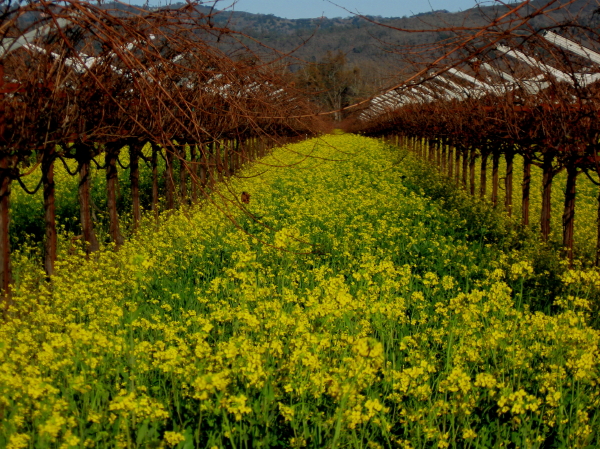
As the year 2009 closes out this week, most of us have a sense that age and time are fleeting. It seems as if it was not that long ago that many of us were throwing the door open and greeting the arrival of 2009 with hope and enthusiasm. As we prepare to do the same for the arrival of 2010, we cannot forget that many things do get better with age (particularly wine).
At one point or another we’ve all heard the famous pun that something or someone is like a fine wine and gets better with age. While generally wine does age well, what do we really know about aging wine? Do all wines age well? When does aging begin and how does it happen? Moreover, why is it desirable that a wine age well? And just how long are wines supposed to age?
These questions are all valid and crucial in order to flush out fact from fiction about a wine’s ability to age. Generally, red wines age better than white wines. This is not to say that there are not some white wines that can age, but in this article, red wines will be addressed.
When does the aging process begin?
The aging process actually begins once the wine commences the fermentation process (which occurs early on during the winemaking process). After fermentation completes, the wine in its newly changed state begins its journey through the aging process. Next, the wine is placed into wood barrels (often times oak) and it will be aged there for a length of time which is highly influenced by the winemaker’s discretion. Part of the rationale behind barrel aging is that due to the type of wood, size of the barrel and time spent therein, the wine will take on aromas and flavors as a result of the wood and pick up more tannin to create structure. Not all red wine grapes benefit from long time periods of barreling in wood because if allowed to stay too long, the wine will become overpowered by the flavor of the wood (often times recognized in some wines as heavy notes of cedar) and the natural attributes of the grape will become lost. Once removed from the barrel, the wine is then bottled and set aside in a cool dark area to sit and more importantly, continue aging. Depending on the grape in the bottle, most red wine grapes benefit from what is known as “extended bottle aging” which can easily exceed twelve months. And if you can resist and store the wine properly at home, the longer that bottle of red wine sits, the more it ages.
What is the benefit of aging wine?
Aging a quality red wine will permit the wine to become smoother over time, lessen in tannins, lose a possible harsh quality and overall develop more complexity. Not all red wines are intended to age for decades upon decades. Heartier grapes such as cabernet sauvignon wines (provided that it is a quality wine) can age beyond ten years if not for twenty years or longer. Similarly, some ports and zinfandels can age ten years or longer. However, other zinfandels peak in the aging process around six years post-bottling. Sangiovese, for example, ages best up to ten years (where it generally peaks).
Selected as a model to show the benefits of aging is a ten year-old bottle of wine, a 1999 vintage of Sangiovese from Benessere Vineyards (“Benessere”). In order to best learn about the benefits of aging a particular wine, it is advisable to set aside a vintage of a wine with which you are very familiar. Benessere specializes in making Sangiovese and moreover, throughout the years I have grown very familiar with its Sangiovese and know what to seek from it.
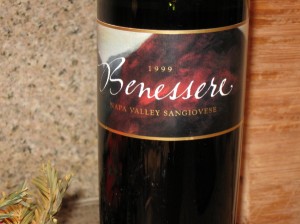
Sangiovese is an easy drinking red wine that is suspected to originally hail from Tuscany. Visiting Italy, it is the one red wine grape that is commonly planted. Generally, the wine’s coloring is not as dark and robust as other red wines. Depending on the winemaker and the grape clones used, the wine is also not as fruit forward but can be earthy (which in turn means that the location where the grapes are planted will greatly affect the flavoring and nuances in the wine).
Upon opening Benessere’s 1999 Sangiovese, the nose is readily sultry and seductive, immediately showing off its aptitude for complexity. Greeted by nuances of red fruit, a hint of licorice, warm spices and a slight earthiness, this wine entices the senses and wakens the mind to contemplate the wine’s journey to arrive at this present state. Admiring the wine in the glass, its coloring has withstood ten years of sitting in the bottle and still reflects jewel tone ruby colors. As the 1999 Sangiovese meets your mouth, your palate is ensconced by smooth, almost velvet-like characteristics. While not as pronounced the fruit is still present adding a juicy sensation, but the wine is more notably characterized by notes of pepper, a mild smokiness, and an easy fading simple finish. In short, the 1999 Sangiovese is one quiet, smooth character and loaded with subtleties.
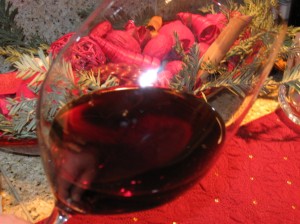
Given the depth and complexity of the 1999 Sangiovese, it could simply be enjoyed by the glass alone. But what if you wanted to pair it with food? Generally when serving an aged wine, I prefer to keep my menu and ingredients simple so as to not overwhelm the wine. To pair with the 1999 Sangiovese, this week’s menu simply presents:
· Grilled Baby Portobello Mushroom Parmesan Sourdough Baguette Slices With Seasoned Marinara Dipping Sauce
Sautéing some sliced baby Portobello mushroom slices in white wine and butter is intended to mirror the slight earthy notes found in the wine.
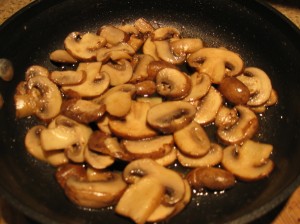
Prior to topping the slices of sourdough baguette, the bread is lightly brushed with olive oil and then grilled to allow a firmer consistency. After the mushrooms are placed atop the slices, they are decorated with shredded parmesan cheese and briefly tucked into the oven to melt and meld the flavors together. Next, chop some fresh basil and oregano to dress up your favorite marinara sauce and heat to create a casual, simple dipping sauce.
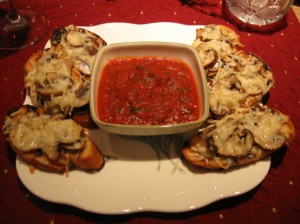
Pairing something simple such as these mushroom parmesan sourdough baguette slices with the 1999 Sangiovese permits the wine to continue to stand on its own and display the complexities well-earned from ten years of bottle aging. While enjoying an aged wine, one can sit back and reflect on how that wine has evolved into the wine it is today and where it would go in the future. And as the year 2009 closes out, an aged wine proves fitting as one reflects over the past year and wonders where 2010 will go.
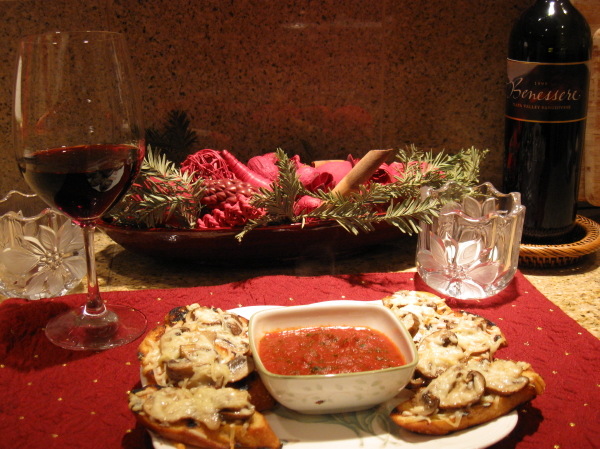
Comments Off on Better With Age